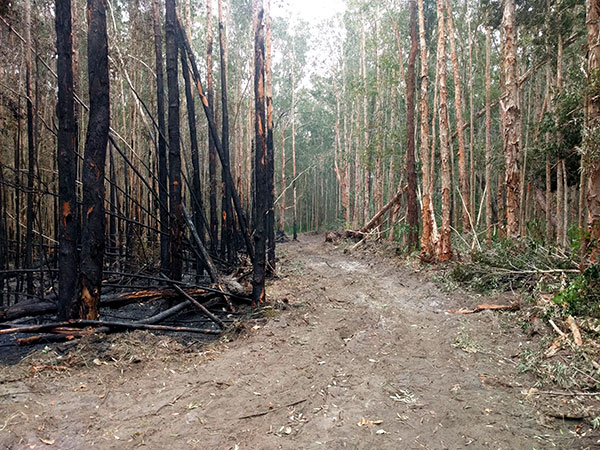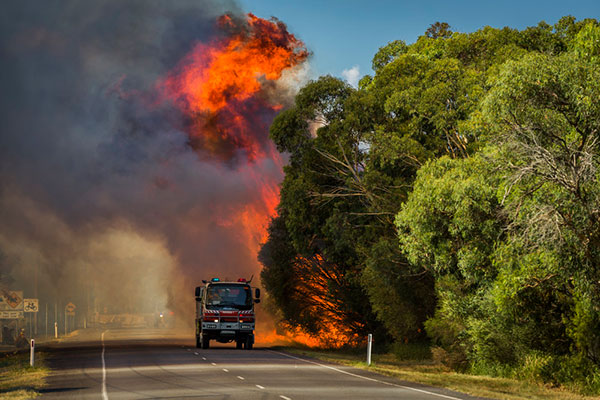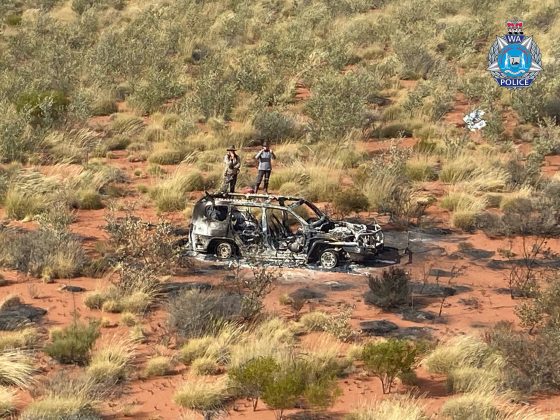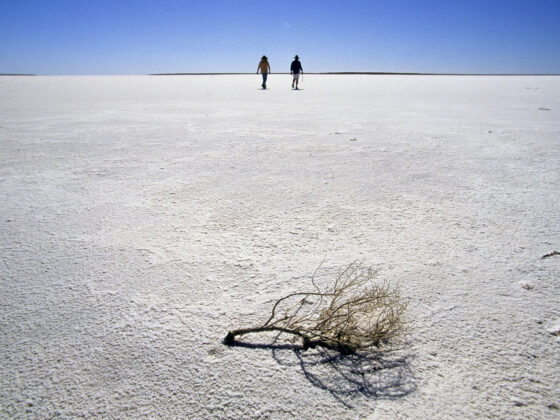Check out our handy guide on bushfire safety for four-wheel drivers explaining what to do if you get caught in a bushfire situation while you’re out camping.
Hopefully, by now, you’ve already sorted out your bushfire survival plan for you and the family if you get a bushfire near home (if not, head over to here and sit down with the family tonight and get this done – it will save lives). But do you know what to do if you get caught in a bushfire situation while you’re out camping or on a day trip into a national park or state forest?
We had a chat with the awesome folks over at the New South Wales Rural Fire Service (NSW RFS). Together we’ve knocked up this essential guide to fire survival, to help keep you and your family safe.

PREPARATION IS KEY
Before we even get to what to do when the proverbial defecation hits the oscillator (see what we did there?), being well prepared is the most critical aspect of not getting in strife out in the scrub. We’re not talking about having the fastest four-wheel drive to get you outta Dodge .But more about checking what’s happening where you’re generally heading and whether you even want to go in the first place.
First and foremost, get the ‘Fires Near Me’ app. It’s available on Android and iOS, it’s free, and is (usually) updated within minutes of a fire phoned into 000. You can see a map showing what’s happening around you and also look throughout the whole state to where you’re heading. Mind you, you’ll need phone coverage. So you may not be able to rely on this out the back of buggery where there’s no reception.
Next off the bat, you can check fire danger ratings via the same app, or on the NSW RFS website. Most weather apps will also give you an indication on them too; however, they are known to change throughout the day if they have a wind or weather change that wasn’t forecast.
Knowing what the weather is going to do piggybacks on to the fire danger rating. Fire danger ratings take in to account the weather (temp, wind speed, humidity and dew point among other things). Sitting here in a beautiful 25-degree day with 60% humidity and 5km/h winds planning a trip for tomorrow without knowing what’s going to happen isn’t wise. Chances are, the very next day could be 35 degrees, with 10% humidity and blowing at 70 km/h.Iit happens, so keep an eye on the weather forecast.

Know how to get help
The National Parks and State Forests websites will often have information on specific parks and forestry areas. They’ll have information if there is a fire burning in a particular park; and will do a blanket park closure for an area if fire conditions reach a certain level (usually Severe or Extreme). Once they hit this level, hopefully, you’ve already decided to call off the trip.
Being able to call for help is a big one too. Whether you happen upon a wildfire and want to report it, or get caught by one and need to call for help, your mobile phone may not cut it. Unless you’re near a repeater station, chances are the UHF won’t be able to get you to help either. Side note: Channel 5 is the emergency repeater channel if you need to use it. So if you’re heading somewhere remote, or a known phone reception black spot in high fire danger, put off the trip or have another way to call for help, like a satphone or EPIRB.
Having an emergency survival kit is worthwhile too. I’m not going to go all ‘doomsday prepper’ on you. But packed away with the first aid kit you should have a battery-powered radio, waterproof torch, woollen blanket (fire blanket) and some towels you can wet to put over your mouth in a pinch. Plus all the standard stuff you would have anyway (is there a Multitool in your kit? There should be).
If for any reason you’re a bit unsure if you should go on that camping trip or day trip, don’t. It’s better to put it off for a weekend and spend the time in the shed working on your rig, or at the beach with the kids, than take an unnecessary risk.

IF YOU GET CAUGHT IN A FIRE
If you do happen to find yourself in a fire, or in the path of a fire, this is what you need to know. Before you even leave home, make sure you have your fire kit with you, and tell someone where you’re heading and when you expect to be home. That way they know where to send the authorities if something untoward were to happen.
Stay in your four-wheel drive! That’s the obvious one. It’s safer in your vehicle, they’re easier to find. And there’s a good chance any helicopters that are called in to recce the fire, or start water bombing operations, they’ll see your rig in the firing line and get someone there pronto.
While you’re out and about, if you do see flames or an unattended fire, call 000 first and foremost. Advise the operator what you’ve seen and the best location information you can get them; GPS coordinates work great if you’re in the bush, or trail/road name. Tell them whether you’re at risk and whether you’re able to get out of the area. If you’re unable to get out, they’ll get help to you as the priority.
What to do with your 4X4
Next, you’ll want to get your vehicle off the road, in as clear an area as you can find. Preferably on bare dirt or the shortest grass you can find. Parking over scrub or ferns will not do. Not parking under or near trees should be an obvious one. Fires generate their own wind, enough to blow old trees over. Once they’re burning they become compromised (they’re called widow-makers for a reason).
If possible, point the front of your four-wheel drive towards the fire. If the car does start to burn and you need to evacuate, you’re sheltered by the doors when you open them, and have a straight run away from the fire, instead of having to go around a door. Put both your headlights and hazard lights on, so someone will be able to find you through the smoke. When the fire approaches, stay below the level of the windows, to protect yourself from radiated heat. You’ll want to close all your vents and windows to limit the smoke that can enter your vehicle too. Keep calm.
Remember we spoke about having a woollen blanket with you earlier? Get it out and cover yourself and your family with it for added protection. Same goes with that damp cloth over your mouth and nose to minimise smoke inhalation. This should go without saying, but hopefully, you’re well-hydrated already. Make sure you have drinking water at hand and keep hydrated as best you can.
Once the fire and sound (trust me, you’ll know the roar when you hear it) of the fire has passed, carefully leave the car. The exterior will be hot, and the ground will be too. But it’s a lot safer on the burnt ground than it is in unburnt terrain.

What if you’re on foot
If for whatever reason you’re no longer with your vehicle, similar rules apply. Get yourself to bare ground, or that with the least amount of vegetation. Remembering leaf litter on the ground burns, and well too. If you can find an area with a depression or ‘trench’ and you have time, clear any leaf litter out, and hunker down in the depression. There have been incidences where a fire has burnt across the top of a person in a depression. They‘ve survived with some minor superficial burns, whereas if they were just out in the open, they probably would not have survived.
You also want to ensure you have woollen clothes with you – or cotton at the very least. Synthetic materials (nylon, polyester) melt when they get hot; suffice to say you don’t want them melting while you’re wearing them.
Hopefully, with these thoughts in mind, you’ll stay safe and never get yourself in a bushfire situation. If you do, these tips will give you a solid idea on how to keep you and your family safe.

FINAL THOUGHTS
Hopefully, with having a leisurely read of this guide, the knowledge imparted will help keep you and your family safe. Something worth thinking about too while fire season begins ramping up, many local brigades are screaming for members. You don’t need to be retired or your own boss. Most brigades will take just about any help they can get at any time. Each year our fire seasons seem to be getting worse, and it’s the volunteers that will turn up to save you and your family when you need them most.
I can tell you the pay is terrible. And there are long hours involved. But you’ll meet some fantastic people, make some great life-long mates, learn some incredible skills and get to do a service to your community. If you can spare even a few hours a week to give back, I’m sure your local brigade would love to have you. Get in touch with them and have a chat about joining up.














